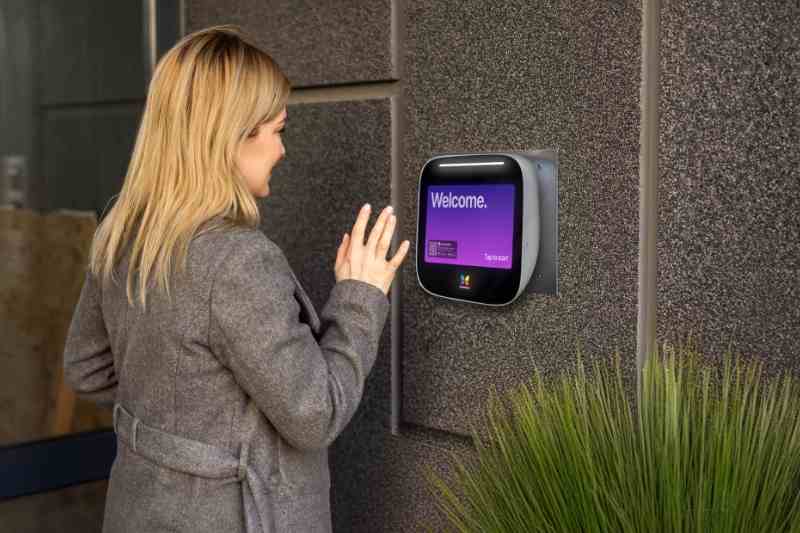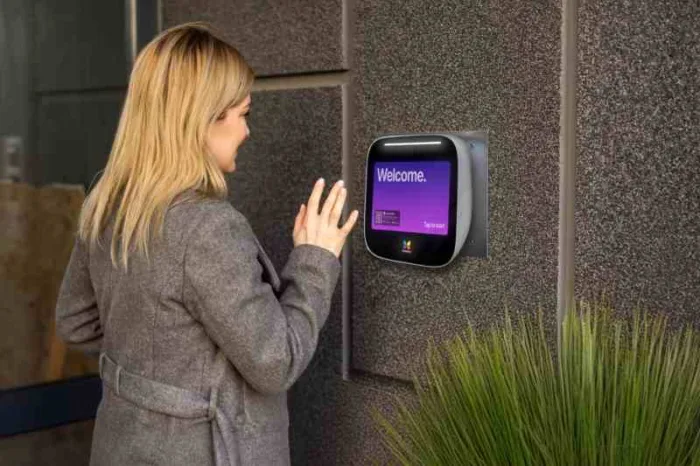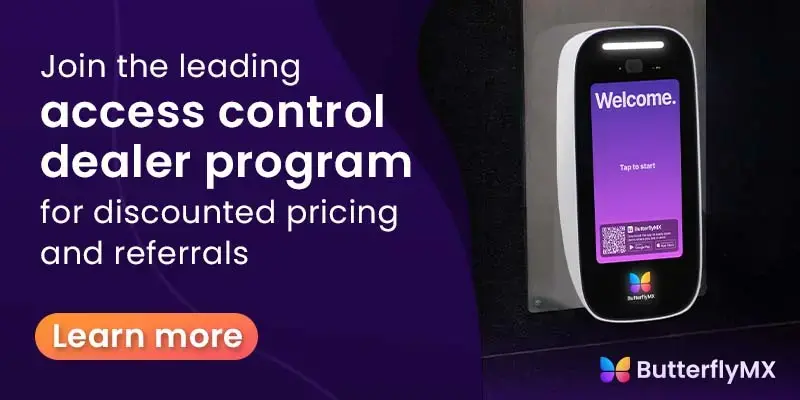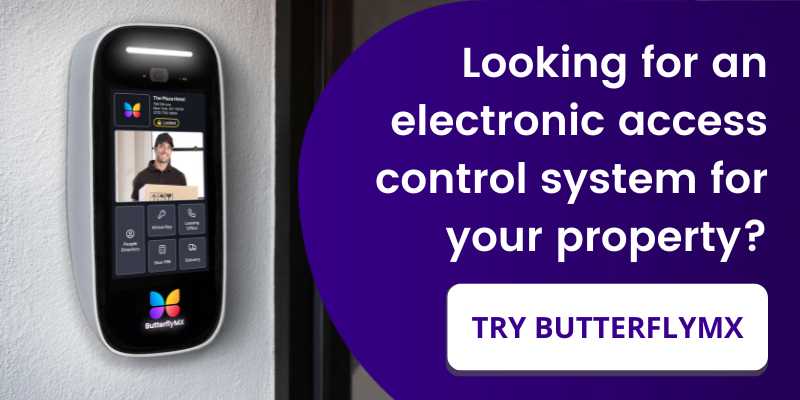Key takeaways
- Electronic access control is the best way to secure your building without hampering access for tenants and staff.
- Card readers, keypads, and smartphone-based systems all have advantages over traditional, legacy lock-and-key systems.
- When you’re looking for an electronic access system, be sure to emphasize features like cloud-based software and solutions for delivery couriers. Mobile access in particular is especially convenient for residents and staff alike.

The field of access control has come a long way. Today, electronic access control systems dominate the market. And more and more property managers and developers are embracing electronic access control for both residential and commercial properties.
In this ultimate guide to electronic access control systems, we explain what electronic access control is. Then, we go over a few common types of access control systems, outline their advantages, and finally list the features you should look for when buying an electronic access control system.
This post covers:
- What is electronic access control?
- Components of electronic access control systems
- What are 3 types of electronic access control?
- Electronic access control advantages
- Features to look for in an electronic access control system
- The ideal access control system
What is electronic access control?
Electronic access control is a method of controlling who can access a space that involves installing electrically powered locks and credential readers.
In the past, access control systems were entirely mechanical. Think of your standard lock and key. However, as technology has evolved, so has access control.
Today, access control providers use innovations like cellular networks, RFID technology, and the Internet of Things to introduce new ways for buildings to verify a person’s identity. New kinds of electronic keys can use inventions like transmitters or magnetic stripes to store and exchange data with readers.
Plus, with the help of electronic equipment and data storage capabilities, today’s access control systems can provide property managers with a tamper-proof audit trail.
Components of electronic access control systems
An electronic lock access control system has these parts:
Credential
A credential is any physical token or digital form of identification that a resident can use to gain entry into a building.
For example, a key card and key fob system will scan a physical credential, while keypads accept PIN numbers as credentials.
Reader
Residents verify their identity by inputting their credentials into a credential reader. The reader sends that data to an access control panel for comparison.
Readers use different technologies depending on the kind of system you choose. You can choose between readers that use Wi-Fi, RFID, Bluetooth networks, and more.
Access control panel
The access control panel is the brain of the entire system. It’s essentially a computer that holds a database of credentials and verifies the data it receives from the reader.
Additionally, when a staff member wants to make changes or edit permissions, they use the access control panel to make those changes.
Electronic door lock
The electronic lock engages and disengages at the direction of an electric current. An electric door lock unlocks after the control panel successfully verifies the credential.
After a short period of time, the lock engages again to ensure that nobody following behind can get unauthorized access to the property.
Watch how ButterflyMX works:
What are 3 types of electronic access control?
Today’s electronic access control systems offer a lot of options. You can tell the difference by looking at the type of credential reader the system uses.
Here are three common types of electronic access control systems:
1. Key fob and key card reader
Fob and card readers are a type of electronic door access control system that uses a small plastic device as its credential. Cards and fobs use wireless technology like Bluetooth, radio frequencies, or RFID access control tags to interact with the reader.
Assigning cards to residents comes with one great advantage. If a resident loses their fob, you can quickly print and assign a new card with the correct credentials at much smaller costs than it would take to recut a traditional key.
2. Keypad
Keypad access control doesn’t require the user to carry a physical credential. Instead, users memorize a preset PIN number that they input into the keypad. You can program a keypad so that every tenant uses the same PIN, or you can assign unique PIN codes to each tenant.
3. Smartphone-based
Smartphone-based access control systems allow residents to open the door using a Bluetooth connection or an app on their smartphones.
The smartphone is the perfect electronic access control device because of the power, versatility, and convenience of using one instead of a physical key or fob. With a smartphone-based system, there’s no risk of losing your key and getting locked out. And in the event that a user doesn’t have their phone on them, most mobile access systems include a backup form of access, like a keypad.
Additionally, some mobile access control systems come with cameras that can send a video feed to a resident’s smartphone for added convenience.
Electronic access control advantages
Compared to a legacy mechanical system that depends entirely on physical keys and locks, electronic access control has multiple advantages.
Three examples of electronic access control benefits include:
Greater convenience than the traditional lock and key
Key cards and keypads are more convenient than traditional metal keys. You save money in both cases because you’ll no longer have to copy and recut keys, a tedious process that often involves sending a staff member to an offsite locksmith. In contrast, you can easily reprint a key card using hardware you keep on the property. And you won’t have to deal with giving residents credentials at all if you use keypads to secure your property.
However, the most convenient form of electronic access control is a smartphone-based system. While keys are easy to forget or lose, people rarely leave home without their smartphones. This makes phones a great credential for access control systems.
Additionally, smartphone-based systems allow residents to access features like Visitor Passes. These are mobile credentials that residents can text to visitors for increased convenience. This is great for granting access to recurring visitors, like friends or service providers.

ButterflyMX is a convenient choice that thousands of property managers depend on.
Manage multiple entryways
Your building certainly has more than one entryway. For example, in addition to your front door, you might also have to manage access to parking access control systems, garages, gyms, and rooftop spaces.
With a mechanical system, multiple entryways mean multiple access control systems that you’ll have to manage separately. However, electronic access control systems can communicate with each other and update permissions automatically — while in contrast, you’d have to manually update each mechanical access point to achieve the same result. It’s the difference between tediously cutting and passing out multiple keys to the same resident. Or pressing one key that automatically gives a resident all the access permissions they need.
Secure audit trail
Using an electronic door entry system, your staff will always know who’s coming and going into and within the building.
Electronic access systems keep track of when someone opened a door and which credential they used. This audit trail helps staff secure the premises. Staff can also easily grant or revoke permissions as needed, without any hassles or delays.
Features to look for in an electronic access control system
Differences between methods of electronic access control mean that you have a lot of options to choose from. Here are the features you should look for when choosing the best electronic system for your property.
When buying an electronic access control system, you should look for:
Visitor management features
Your residents aren’t the only people who will be entering your property. Visitors, from friends to delivery couriers to house cleaners, will also need access. And it’s important to make sure that authorized visitors have unimpeded access while maintaining high levels of security.
The best way to maintain a secure property without impeding access is to give each resident a way to verify their own visitors and unlock the front door remotely. This way, renters can grant access to visitors without having to go down to the front door themselves. So, choose an effective visitor management system.
The best access control system that manages access for visitors is a smart video intercom. These systems offer two-way video calls that allow a resident to visually verify who’s requesting access. They also enable remote access, which means that a resident doesn’t even have to be home for a visitor to gain secure, verified access into the property.
Cloud-based
To simplify access management, choose cloud-based access control systems. When software is cloud-based, that means you can update the system from anywhere and from any device. As a result, crucial tasks — like updating resident permissions or adding and removing tenants — can be performed no matter where an employee is.
Some electronic access control systems aren’t cloud-based, which makes them much harder to manage because they’re limited to one access control software download for one machine. In these cases, staff members can’t update the system from offsite, which hinders staff control over the system and might cause hangups for residents.
Delivery solutions
Online shopping has exploded in popularity over the last few years. As deliveries of items from food to furniture become an everyday fixture in your residents’ lives, they’ll come to expect an access control solution that simplifies package delivery.
So, look for an electronic access control system that allows residents to issue Delivery Passes, which are one-time access codes that a delivery courier can use to seamlessly enter a building. You can also use an electronic access system to control access to a designated package room, where couriers can safely leave packages. That way, parcels aren’t left in the lobby, where they’re susceptible to theft.
The ideal access control system
Whether you’re looking to increase convenience for residents or save time for staff, you can count on ButterflyMX for industry-leading electronic access control.
We know that every property has unique needs – and that’s why we provide you the tools to manage access for interior and exterior spaces alike. In addition to our flagship Video Intercom, we can secure entryways with electronic access control door hardware with Keypads, Card Readers, Security Cameras, and even Vehicle Access Control stickers for properties with gates garages.
ButterflyMX access hardware lets residents choose between multiple ways to open the door. They can use an intuitive app on their smartphones – access is as easy as one swipe. Smartphone access is a great complement to traditional electronic credentials like PIN numbers and fobs.
Don’t just take our word for it. Over 15,000 door access control systems for offices and residential buildings run on ButterflyMX, and we have over 20,000 five-star reviews. Join property managers across the country in making access simple with ButterflyMX.







